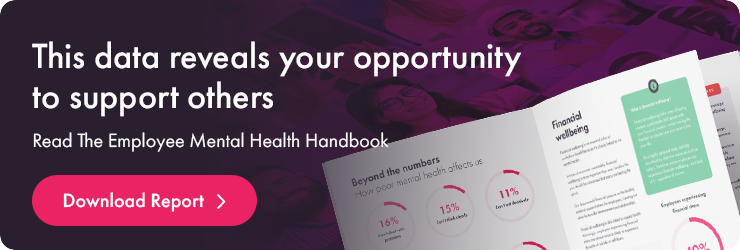With evidence indicating that a mental health epidemic is occurring, it’s essential for employers to know how to improve mental health in the workplace.
Every employee exists somewhere on the mental health continuum, from surviving to thriving. It’s normal for their position on this continuum to fluctuate. However, our employee wellbeing statistics show that the mental of our professionals is currently under significant strain.
Data from the Workplace Health Report revealed that 60% of workers are experiencing symptoms of anxiety, 56% of workers are experiencing symptoms of depression, and 76% are experiencing moderate-to-high levels of stress.
It has therefore never been more important to prioritise the mental health of our workforce. With that in mind, here’s 9 tips on how to improve mental health in the workplace.
- Look after yourself
- Lead from the front
- Pay attention and trust your instincts
- Raise awareness around mental health
- Keep the conversation going
- Know where to go for further support
- Prioritise work-life balance
- Implement mentally healthy workplace practices
- Prioritise confidentiality and anonymity
Read on for a more detailed look at the ways you can improve mental wellbeing in the workplace.
1. Look after yourself
If we’re to do the best possible job of looking after our teams, we need to look after ourselves first.
At Champion, we often refer to the oxygen mask analogy to explain this point. When you’re on a plane, cabin crew will advise you to put your own oxygen mask on first, before helping anyone else.
Now, this could come across selfish, but it’s actually selfless; if you did not put on your oxygen mask on first, you’d quickly run out of air and not be able to help anyone else.
The same applies to mental health. If helping others constantly comes at the expense of your own mental and physical wellbeing, you may eventually become exhausted, frustrated and burned out.
So put on your oxygen mask first, by setting aside a minimum of 20 minutes every day for self-care activities. You could read, exercise, ring a friend, take a bath, whatever you like. You could even take this time to do nothing at all.
2. Lead from the front
Employees take cues from how their leaders behave. This means employees in senior positions are key resources when it comes to highlighting the importance of mental health and wellbeing.
For instance, we find that leaders who open up about their mental health has a huge impact on easing the load that other people may be experiencing.
Leaders are just as likely as anyone to go through tough times. When this happens, the old leadership style would have been to grin and bear it – to not show any ‘weakness’ to your team.
However, by discussing their experiences openly with their team, leaders can help to create psychologically safe spaces in which everyone feels comfortable to open up themselves.
3. Pay attention and trust your instincts
Spotting the warning signs of a colleague struggling with their mental health can sometimes be hard, especially as more and more people now work remotely.
But the one thing to keep in mind is that if something doesn’t feel quite right with someone, it probably isn’t.
You might notice that they don’t quite seem like their usual self – they might start turning up late, being snappy or unusually quiet. There are also other signs of stress in the workplace that you may pick up on.
If you think something is not quite right, this is the time to start the conversation.
By being initially proactive about starting these conversations, you will make it more likely that team members will in time approach you themselves when they’re struggling.
Whether you approach them, or they approach you, the following graphic we produced provides a simple framework for how you could go about supporting them.
Remember, there’s no substitute for demonstrating compassion and empathy throughout the conversation.
4. Raise awareness around mental health
There’s a huge stigma around talking about mental health in many UK workplaces. Employees remain too reluctant to talk to their managers about any mental health issues they may be having.
Break this stigma by promoting discussion about mental health and wellbeing in the workplace. You could do this by:
- Embedding mental health training into your inductions
- Utilising internal communication channels, such as blog posts or staff newsletters, to raise awareness
- Encouraging people at all levels to speak openly about their mental health, if they are comfortable doing so
Raising awareness about mental health in these ways sends a clear message to employees that support is available if they are struggling.
5. Keep the conversation going
We all have mental health, all the time, so we need to be continually talking about it. This means encouraging your employees to keep the mental health conversation going.
Lead the way, by arranging regular one-to-one meetings with members of your team, during which you discuss their mental health.
Outside of meetings, be sure to continually check in on your employees, and ask how they are. To be more effective, ask them twice.
Research from Time to Change shows that 75% of people will say they’re okay, even if they’re not. By simply asking twice, you may uncover an issue that you might previously not have found.
By keeping this conversation going, you will help staff to think more about their mental health, or that of their colleagues, and reflect on the factors that affect this.
6. Know where to go for further support
No one is expecting you to be an expert on everything with regards to mental health and wellbeing; there will always be issues to deal with that are outside of your capabilities and experience.
When this happens, it’s important as a leader to know your limits, including when and where to signpost to other services.
To ensure you’re well-prepared, find out what your company offers in relation to Employee Assistance Programmes or other wellbeing initiatives, and communicate it clearly and regularly.
On top of this, you might also want to suggest other resources, such as helplines and support guides outside of the organisation.
For example, when developing our Eating Disorders in the Workplace guide, we made sure to recognise that employers should also look beyond the guide to charities and helplines.
7. Prioritise work-life balance
The boundaries between work life and home life have become increasingly blurred with the significant shift to home working. This needs to be monitored carefully, as a poor work-life balance is a shortcut to stressed and burned out employees.
So, take proactive steps to keep your employees’ work/life balance healthy. You could encourage your staff to work sensible hours, ensure they take full lunch breaks, and advise them to avoid working at weekends.
It is also important that you set realistic work demands, to ensure that your workers do not have extra work to do after hours.
You can guide your work demands using the SMART Goals framework; a tool that can be used to ensure the goals you set are specific, measurable, achievable, relevant and time-bound.
8. Implement mentally healthy workplace practices
Boost your team’s mental wellbeing, by implementing some simple healthy workplace practices.
For office workers you should encourage your employees to frequently break long sitting periods, as this has been shown to enhance mood and boost energy levels.
You could also encourage exercise and regular social events to boost the physical and mental wellbeing of your staff.
Implementing practices such as these highlights your dedication to your staff’s wellbeing.
Find more tips in this guide covering how to introduce wellbeing at work.
9. Prioritise confidentiality and anonymity
It is vital that your workforce know that they can approach you about any issues they might be having in the utmost confidentiality.
With a 2021 report from Mind emphasising the importance of confidentiality in mental health, this is a key element of promoting wellbeing (whether remotely or in-person).
Many employees still worry that if they open up about their mental health, the conversation will not stay private and may affect their careers. These concerns prevent them from discussing their experiences, and often cause them to allow issues to worsen.
Make it clear to your staff that you take their privacy seriously, and that opening up about their mental health, or using mental health resources, will never be tracked or used against them.
How to improve mental health in the workplace: Closing thoughts
To wrap up our guide on how to improve mental health in the workplace, it’s important to consider the following. Prioritising mental health is not just about avoiding undesirable outcomes, it’s also about giving your employees the opportunity to be the best versions of themselves.
So, when you’re promoting mental health and wellbeing, make it clear to your employees that improving their mental wellbeing is not just about reducing stress or avoiding burnout.
It’s also about performing well, feeling good and thriving, both inside and outside of work.







